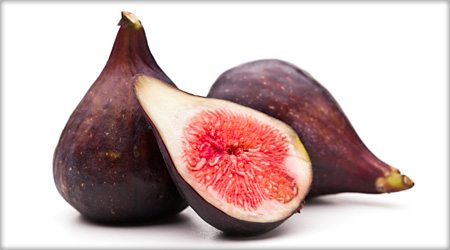
It’s not hard to figure out why an introverted flower, which is commonly referred to as a fruit, has been revered by mankind since the beginning of civilized existence. Although July through September is the fresh market season for this succulent crop, there’s never a bad time to discuss the addictive fig.

Figure These Facts
With several hundred varieties of the epicurean delight in existence, some of the most popular selections are commonly grown in America and can be found in today’s markets. Scientifically known as the Ficus Carica, well-known varieties of fig include:
• The deep purple Black Mission Fig, which darkens to a rich black hue when dried.
• The Calimyrna Fig, which is known for its nutty flavor and golden skin, and is normally consumed when ripe.
• The Kadota Fig, which is practically seedless, has a thick skin and is a creamy amber color when ripe. This type is often canned and dried.
• The Brown Turkey Fig. A variety used exclusively in the fresh fig market, it has copper-colored skin, blushed with hints of purple and contains white flesh that will gradate to pink in the center.
The fig is a member of the mulberry family of vegetation and is a native fruit from Turkey. It is praised for its chewy flesh, smooth skin and the small, crunchy seeds the foliage produces. The entire spectrum of figs could easily produce a rainbow of color and a plethora of texture due to the fantastic range in each variation. Arguably all fruit tastes best when consumed fresh, but the fig can only be harvested once ripe.
A High Figure of Uses
A pinch of imagination, a sprinkle of time and a dash of culinary adventure provide the perfect recipe for creating any irresistible fig dish. The simplest preparation is serving it fresh. Wash the sweet-smelling fruit under cool water, wipe it dry with a soft cloth or tissue, de-stem, and the fig can be eaten peeled or whole. Fresh figs can also be dried by the sun or artificially, which will change the texture, will profoundly extend its naturally short life and protect the thin, easily bruised skin from damage during shipment.
Typically fresh figs should be eaten directly after harvest, though they can be refrigerated for up to three days in an airtight container or sandwich bag. Conversely, dried figs can last for up to eight months. Whether fresh or dried, the abundance of gastronomic abilities for all variations of fig is nothing less than phenomenal.
Figs can be enjoyed in salad, jam, chutney, cakes and as a topping for hot cereal or frozen desserts like gelato and ice cream—fig poached in fruit juice or red wine has proven to be an excellent garnishment for yogurt. Figs are great on pizza, in smoothies or as an addition to soup, stews, muffins, cakes and pies. Savory dishes like poultry, venison and lamb are also enhanced by the enriching flavor of fig. Stuffed figs, fig marinades as well as fig with seafood or even breakfast meats are other bold culinary uses. When made into a purée, dried figs can be engaged as a replacement for up to half the recommended amount of fats such as shortening, margarine, butter or oil in recipes for baked goods. With so many possibilities of use, it’s fortunate that the fig is also a very health-friendly treat.
Good for the Body and Overall Figure
It is rumored that renowned Greek philosopher Plato promoted the fig as being the only nutrition for athletes and encouraged Greek sports competitors to eat many figs. In fact, the Greek government allegedly once forbade all export of figs to assure themselves a victorious outcome at the Olympic games. And though this practice is not recommended, it is said that humans can live on the fig alone. Whether tale or truth, incorporating figs into the diet can contribute to overall health and be part of a well-balanced meal.
Figs are an excellent source of energy and contain antioxidant vitamins A, E and K, all of which protect the human body from cancers, diabetes, degenerative diseases and infections. Chlorogenic acid in figs helps to lower blood sugar levels and manage blood glucose in type 2 diabetes. In addition, dried figs are a wonderful for obtaining substantial amounts of calcium, iron, potassium and zinc, all of which contribute to controlling of the human heart rate and blood pressure, and the production of red blood cells.
The soluble dietary fiber provided by fresh and dried figs is effective for weight loss, and the tasty fruit is also low in calories.
Time and again, scientific reports have shown that fresh fruit is critical for overall health, and with the fig being the “grandfather” of cultivated fruit, in addition to all the nutrients, taste and culinary ability it has to offer, it’s not hard to figure out why this handful of goodness is so highly respected.
References:
Fig fruit nutrition facts. (2011). Retrieved from http://www.nutrition-and-you.com/fig-fruit.html
Figs. (2011). Retrieved from www.whfoods.com/genpage.php?tname=foodspice&dbid=24
Fig. (2011). Retrieved fromwww.thefruitpages.com/figs.shtml
Fruit of the Month: Figs. (2011). Retrieved fromwww.fruitandveggiesmatter.gov/month/figs.html
